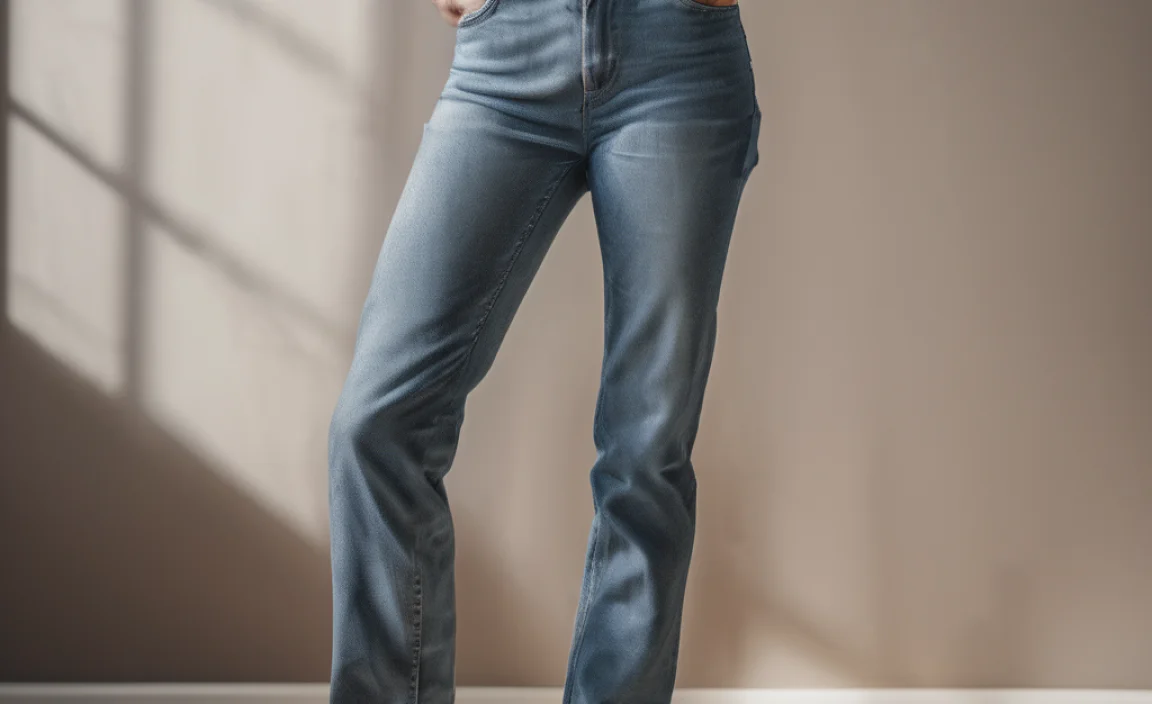How to Hem Mom Jeans: Proven Results
Learn how to easily hem your favorite mom jeans at home! This guide provides simple, step-by-step instructions with proven results, ensuring a perfect, customized fit without a trip to the tailor. Get ready to rock your perfectly fitting denim.
How to Hem Mom Jeans: Get the Perfect Fit Every Time
Mom jeans are a style staple, but that perfect relaxed fit can sometimes come with a slightly too-long inseam. Don’t let a pesky hemline keep you from rocking your favorite pair! Whether your jeans are a tad too long or you’re aiming for a specific cropped look, hemming them yourself is surprisingly simple. This guide will walk you through everything you need to know, from gathering your tools to achieving a professional-looking finish. You’ll gain confidence and save money, all while giving your denim a fresh, customized feel.
Why Hem Your Mom Jeans?

The beauty of mom jeans often lies in their slightly shorter, looser silhouette compared to skinny jeans or straight-leg styles. However, “slightly” can be subjective, and sometimes the original length just doesn’t hit right. Here are a few common reasons why you might want to hem your mom jeans:
- Achieving the Ideal Crop: You might want a trendy ankle crop, a capri length, or a slightly frayed hem that sits just above your ankle bone.
- Taming Excess Fabric: Too much fabric can make even the most flattering jeans bunch up around your ankles, looking sloppy and shortening your legs.
- Repairing Damaged Hems: Over time, the original hem can fray or get damaged. A fresh hem gives your jeans a new lease on life.
- Customizing for Your Height: Standard inseams don’t work for everyone. Hemming allows you to tailor the length perfectly to your individual height and leg proportions.
- Updating an Older Pair: A new hem can completely change the look of a pair of jeans, making them feel current and stylish again.
Tools You’ll Need

Gathering the right supplies makes the hemming process smooth and successful. You probably have most of these items already!
- Your Mom Jeans: The star of the show!
- Fabric Scissors: Sharp scissors dedicated to fabric will give you the cleanest cut.
- Measuring Tape or Ruler: For accurate measurements.
- Fabric Chalk or Disappearing Ink Pen: To mark your cut line.
- Straight Pins: To hold the hem in place while you work.
- Sewing Machine (Optional but Recommended): For a quick and durable stitch.
- Needle and Thread (if not using a machine): Choose a color that matches your jeans or your desired thread accent.
- Iron and Ironing Board: To press the hem and create crisp folds.
- Seam Ripper (Optional): If you want to remove the original hem to reattach it.
- A Friend or Full-Length Mirror: To help with measuring and checking the length.
Step-by-Step Guide: How to Hem Mom Jeans

Let’s get started! This method focuses on a simple, clean hem finish that works beautifully for the mom jean aesthetic. We’ll cover both machine and hand-sewing options.
Step 1: Decide on Your Desired Length
Put on your mom jeans and the shoes you plan to wear with them most often. Stand in front of a mirror or have a friend help you. Decide where you want the hem to fall. Consider the classic mom jean look, which often sits at or just above the ankle bone. Mark the spot with a pin or chalk. Remember, you can always cut more off, but you can’t add it back!
Step 2: Measure and Mark Your Cut Line
Take off the jeans and lay them flat on a clean surface. Use your measuring tape to determine how much you need to cut off from the original hem to reach your desired length. For example, if you want your jeans to be 28 inches long and they currently measure 30 inches from the crotch seam to the hem, you’ll need to cut off 2 inches.
Now, add about 1 to 1.5 inches for the hem allowance. This extra fabric will be folded up to create the new hem. Mark this new, final length with your fabric chalk or pen. Make sure the line is straight and goes all the way around the leg. For added accuracy, measure from the inseam down to your desired hem line on both legs to ensure they match.
Tip: If you’re aiming for a raw or frayed hem, you might only need 0.5 to 1 inch for the fold, or even skip folding entirely depending on the look you want.
Step 3: Cut Off the Excess Fabric
Lay one leg of the jeans flat, ensuring the fabric is smooth and the marked line is easily visible. Using your sharp fabric scissors, carefully cut along the chalk or pen line. Repeat for the other leg, making sure the cut is at the same length. Precision here ensures your jeans will have an even hemline.
Step 4: Prepare the New Hem
Now it’s time to create the folded hem. Turn the jeans inside out. For a clean, traditional hem:
- First Fold: Fold the raw edge of the fabric upwards by about 0.5 inches and press firmly with your iron. This will hide the raw edge.
- Second Fold: Fold again by the remaining amount (which should be the 0.5 to 1 inch you allowed for the hem allowance). Press firmly with the iron to create a crisp fold. Pin the hem in place all the way around both legs.
For a Frayed/Raw Hem: If you want a frayed look, you can skip the folding steps or do just a very small fold (about 1/4 inch) and secure it. Some people skip folding altogether and just let the raw edge be. If you do this, you’ll want to add a stitch line about 1/4 to 1/2 inch from the cut edge to prevent too much fraying. More on that later.
Step 5: Sew the Hem
This is where you permanently secure the new hem. You have two main options:
Option A: Using a Sewing Machine
Thread your sewing machine with a needle and thread that matches your jeans. Set your machine to a straight stitch. Remove the pins as you go and sew along the top edge of the folded hem. Aim for a consistent seam allowance, typically close to the folded edge. Finish by backstitching at the beginning and end to secure the thread.
Option B: Hand Sewing
Thread a needle with matching thread and knot the end. Use a blind stitch or a whip stitch. For a blind stitch, try to catch only a few threads of the main jean fabric on the outside and a bit more of the folded hem on the inside. This will make your stitches less visible from the outside. For a whip stitch, you’ll be folding the hem over and then sewing through both layers. Aim for small, even stitches. Knot securely at the end.
For Frayed/Raw Hems (Machine or Hand): If you opted for a frayed hem and did a small fold, sew along the top edge of that fold, about 1/4 to 1/2 inch from the cut edge. This will create a line of stitching that helps control fraying after you wash them. If you skipped folding entirely, you can sew a line of stitching about 1/4 inch from the raw edge. Some people also sew a second line of stitching about 1/2 inch above the first for more durability. After washing, the fabric will naturally fray between the two stitch lines.
Step 6: Finishing Touches
Turn your jeans right-side out. Give the hemmed area a final press with the iron to ensure it lies flat and looks neat. If you went for a frayed hem, you can gently pull at the threads to encourage more fraying or even use tweezers for more control. Some people like to add a few vertical stitches through the frayed area to create a “bar tack” effect, which adds a distressed look and some stability.
Alternative Hemming Techniques for Mom Jeans

Mom jeans offer a versatile canvas for different hem styles. Here are a couple of other popular options:
The Original Hem Reattachment
This method preserves the original, often slightly thicker, hem of your jeans, which can give a very authentic look. It requires a bit more effort but yields fantastic results.
Steps:
- Assess the Original Hem: Look at the original hem. It usually has a distinct double-stitched line.
- Carefully Remove the Original Hem: Using a seam ripper, meticulously unpick the stitching of the original hem on both legs. Be patient! Gently pull away the excess fabric that was folded up, leaving the original hem band attached to the rest of the jean leg.
- Measure and Cut: Now, measure the length of the jean leg below where the original hem was removed. Decide how much shorter you want them. Cut off the excess fabric, but leave enough length to reattach the original hem band. This is crucial. You’ll essentially be shortening the leg above where the original hem was.
- Reattach the Original Hem: Fold the raw edge of the shortened pant leg inwards (like creating a simple hem). Then, carefully place the original hem band over this folded edge. Pin it securely in place, ensuring the original stitching holes align as best as possible.
- Sew the Original Hem Back: Using a sewing machine with a strong needle, stitch along the original stitch line of the thick, outer hem. This will secure the new, shorter leg to the original hem band. You might need to go slowly and carefully to navigate the thicker fabric.
The Cuffed Hem (Permanent)
For a look that mimics a permanent cuff without the bulk of repeatedly folding them.
- Determine Desired Length: Try on jeans with shoes, and fold up a cuff to your desired length. Mark the bottom edge of this cuff.
- Cut Below the Mark: Remove jeans, lay flat, and measure. Cut off excess fabric, leaving enough for a standard 1-inch double fold hem plus enough for the cuffed portion you want to be visible from the outside. So, if you want a 2-inch cuff, you’ll need about 2 inches for the cuff and 1 inch for the internal folded hem, totaling roughly 3 inches of extra fabric below your desired final inner leg length.
- Fold and Press: Turn jeans inside out. Create the double fold hem (0.5 inch, then 0.5 inch) at the bottom of the fabric you left. Press.
- Create the Cuff: Now, create your visible cuff. Fold the fabric upwards from the bottom to your desired cuff width (e.g., 1.5 or 2 inches). Press firmly. The raw edge of the pant leg is now hidden inside this fold.
- Sew the Cuff: Sew along the top edge of this visible cuff, catching the inner folded hem. If you want a very finished look, you can sew along the bottom edge of the cuff as well, creating a defined band.
How to Hem Mom Jeans with Hydrogen Peroxide (Fraying Technique)

You asked about hydrogen peroxide, and it’s a great tip for enhancing a frayed hem! It doesn’t create the hem itself, but it can help your frayed hem look more worn-in and that classic “bleached” look sometimes seen on denim.
Important Note: Do a test patch on an inconspicuous area of the jeans first, as results can vary based on denim composition and dye. Always work in a well-ventilated area.
Steps:
- Prepare the Hem: First, create your frayed hem as described in Step 5 Option B (or a similar method) where you have a visible raw edge, possibly with a stitch line above it to control fraying.
- Apply Hydrogen Peroxide: Mix a 50/50 solution of hydrogen peroxide and water in a spray bottle. Alternatively, for a more controlled application, you can carefully dab the peroxide solution onto the frayed edges using a cotton ball or old toothbrush.
- Let it Sit: Allow the peroxide to sit for 10-30 minutes. Keep an eye on it. You’ll see the color of the denim lighten. The longer it sits, the lighter it gets.
- Rinse Thoroughly: Once you achieve the desired lightness, thoroughly rinse the hem area with cold water to stop the chemical reaction.
- Wash and Dry: Wash the jeans as usual to remove any remaining peroxide. This will also help the fraying process. Air drying or tumble drying on low heat can further enhance the frayed look.
Hydrogen peroxide works by oxidizing the dye in the denim, effectively lightening it. It’s a safer alternative to chlorine bleach for achieving a sun-bleached or distressed effect.
Comparing Hemming Methods
Choosing the right hemming method depends on your desired look and how much effort you want to put in. Here’s a quick comparison:
| Method | Pros | Cons | Best For |
|---|---|---|---|
| Simple Folded Hem | Quick, clean finish, professional look, durable | May not be the exact look associated with some mom jeans | Classic, neat appearance |
| Frayed/Raw Hem | Trendy, casual vibe, easy to achieve (less sewing) | Can look messy if not done intentionally, may fray excessively over time | Distressed, vintage, or laid-back styles |
| Original Hem Reattachment | Preserves original hem look, authentic vibe, very durable | More time-consuming, requires careful seam ripping and sewing | Maintaining the original jean aesthetic with a custom length |
| Permanent Cuffed Hem | Stylish with two visible stitch lines, eliminates re-cuffing | Requires precise measurement and sewing to look good | Fashion-forward, structured look |
Troubleshooting Common Hemming Issues
Even with the best intentions, you might run into a few snags. Here’s how to fix them:
- Uneven Hem: If your hem looks uneven after sewing, you might need to carefully unpick the stitching and re-cut or re-fold. Using a sewing gauge can help maintain consistent width.
- Wavy Hem: This can happen if you stretched the fabric while sewing, especially with knits or very lightweight denim. Try sewing with less tension or without stretching the fabric. If it’s already sewn, sometimes a good press can help mitigate waviness.
- Skipped Stitches: Ensure your sewing machine’s needle is sharp and appropriate for denim. Check that the thread is correctly threaded and the tension is set properly.
- Too Short: Oops! This is the hardest to fix. If it’s just slightly too short, you might be able to use the original hem reattachment method if you have enough fabric to rejoin. Otherwise, you might need to repurpose the jeans or add a decorative fabric band.
- Too Long (after hemming): Don’t panic! You can always unpick your new hem and re-do it shorter.
Frequently Asked Questions (FAQ)
Q1: Can I hem mom jeans without a sewing machine?
Absolutely! Hand sewing is perfectly effective for hemming jeans, especially for a clean, simple hem or even a visible stitch on a frayed hem. It just takes a little more time and patience.
Q2: Will hemming mom jeans affect their fit or style?
Hemming primarily changes the length. The relaxed fit and silhouette of mom jeans will remain intact. The style can be enhanced or altered depending on the type of hem you choose (e.g., a frayed hem adds more casualness).
Q3: How much fabric should I leave for the hem allowance?
For a standard, clean hem on denim, leave about 1 to 1.5 inches for folding. This allows for a neat double fold. For a less substantial hem or a raw edge, 0.5 to 1 inch might suffice.
Q4: How do I get a clean, sharp crease on my hem?
Ironing is key! After folding and pinning the hem, press it firmly with a hot iron. For extra crispness, you can use a pressing cloth on dark denim to prevent shine marks.
Q5: What’s the best way to get a frayed hem that doesn’t unravel too much?
To control fraying, sew a line of stitching about 1/4 inch from the raw edge. This acts as a stopper. After washing and fraying, the fabric threads will naturally stop at this stitch











